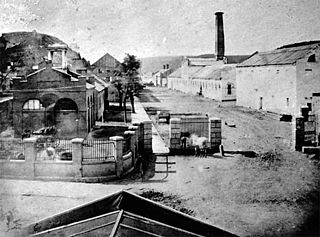
The long rifle, also known as longrifle, Kentucky rifle, Pennsylvania rifle, or American longrifle, was one of the first commonly used rifles for hunting and warfare. It is characterized by an unusually long barrel, a development in American rifles that was uncommon in European rifles of the same period.

The M1903 Springfield, officially the United States Rifle, Caliber .30-06, Model 1903, is an American five-round magazine-fed, bolt-action service repeating rifle, used primarily during the first half of the 20th century.
The Baker rifle was a flintlock rifle used by the rifle regiments of the British Army during the Napoleonic Wars. It was the first standard-issue, British-made rifle accepted by the British armed forces.

The Springfield Model 1861 was a Minié-type rifled musket used by the United States Army and Marine Corps during the American Civil War. Commonly referred to as the "Springfield".
A rifled musket, rifle musket, or rifle-musket is a type of firearm made in the mid-19th century. Originally the term referred only to muskets that had been produced as a smoothbore weapon and later had their barrels replaced with rifled barrels. The term later included rifles that directly replaced, and were of the same design overall as, a particular model of smoothbore musket.

The M1819 Hall rifle was a single-shot breech-loading rifle designed by John Hancock Hall, patented on May 21, 1811, and adopted by the U.S. Army in 1819. It was preceded by the Harpers Ferry M1803. It used a pivoting chamber breech design and was made with either flintlock or percussion cap ignition systems. The years of production were from the 1820s to the 1840s at the Harpers Ferry Arsenal. This was the first breech-loading rifle to be adopted in large numbers by any nation's army, but not the first breech-loading military rifle – the Ferguson rifle was used briefly by the British Army in the American Revolutionary War. The Hall rifle remained overshadowed by common muskets and muzzleloading rifles which were still prevalent until the Civil War. The early flintlocks were mostly converted to percussion ignition.
The British .577 Snider–Enfield was a breech-loading rifle. The American Jacob Snider invented this firearm action, and the Snider–Enfield was one of the most widely used of the Snider varieties. The British Army adopted it in 1866 as a conversion system for its ubiquitous Pattern 1853 Enfield muzzle-loading rifles, and used it until 1874 when the Martini–Henry rifle began to supersede it. The British Indian Army used the Snider–Enfield until the end of the nineteenth century.

The Springfield Model 1840 was a flintlock musket manufactured by the United States during the mid-19th century. The .69 caliber musket had a 42-inch (107 cm) barrel, an overall length of 58 inches (147 cm), and a weight of 9.8 pounds (4.4 kg). More than 30,000 were produced by the Springfield and Harpers Ferry armories and two independent contractors between 1840 and 1846.
The Springfield Model 1812 Musket is a .69 caliber, flintlock musket manufactured by the Springfield Armory.
The Springfield Model 1795 was a .69 caliber flintlock musket manufactured in the late 18th and early 19th centuries in the United States.

The Springfield Model 1865 was an early breech-loading rifle manufactured by U.S. Armory in Springfield, Massachusetts. It was a modification of the Springfield Model 1861. It was later replaced with the Springfield Model 1866.

The Springfield Model 1868 was one of the rifles which used the trapdoor breechblock design developed by Erskine S. Allin.
The M1841 Mississippi rifle is a muzzle-loading percussion rifle used in the Mexican–American War and the American Civil War.

The Harpers Ferry Armory, more formally known as the United States Armory and Arsenal at Harpers Ferry, was the second federal armory created by the United States government. It was located in Harpers Ferry, Virginia. It was both an arsenal, manufacturing firearms, and an armory, a storehouse for firearms. Along with the Springfield Armory, it was instrumental in the development of machining techniques to make interchangeable parts of precisely the same dimensions.

The Richmond rifle was a rifled musket produced by the Richmond Armory in Richmond, Virginia, for use by the Confederate States Army during the American Civil War.
During the American Civil War, an assortment of small arms found their way onto the battlefield. Though the muzzle-loading percussion cap rifle was the most numerous weapon, being standard issue for the Union and Confederate armies, many other firearms, ranging from the single-shot breech-loading Sharps and Burnside rifles to the Spencer and the Henry rifles, two of the world's first repeating rifles, were issued by the hundreds of thousands, mostly by the Union. The Civil War brought many advances in firearms technology, most notably the widespread use of rifled barrels.

The US Model 1842 Musket was a .69 caliber musket manufactured and used in the United States during the 19th Century. It is a continuation of the Model 1816 line of muskets but is generally referred to as its own model number rather than just a variant of the Model 1816.

The Springfield Model 1855 was a rifled musket widely used in the American Civil War. It exploited the advantages of the new conical Minié ball, which could be deadly at over 1,000 yards (910 m). It was a standard infantry weapon for Union and Confederates alike, until the Springfield Model 1861 supplanted it, obviating the use of the insufficiently weather resistant Maynard tape primer.

The 1792 contract rifle is not a specific model of gun, rather it is a modern way to categorize a collection of rifles bought by the United States government in that year. United States 1792 contract rifles are Pennsylvania-Kentucky Rifles with a 42-inch octagon barrel in .49 caliber, with a patch box built into the buttstock. What distinguishes them from civilian rifles is that they were bought by the government under military contract.

The U.S. M1814 rifle was designed by Robert T. Wickham. The manufacturing was contracted out to Henry Deringer and R. Johnson to make rifles for use by the military.












